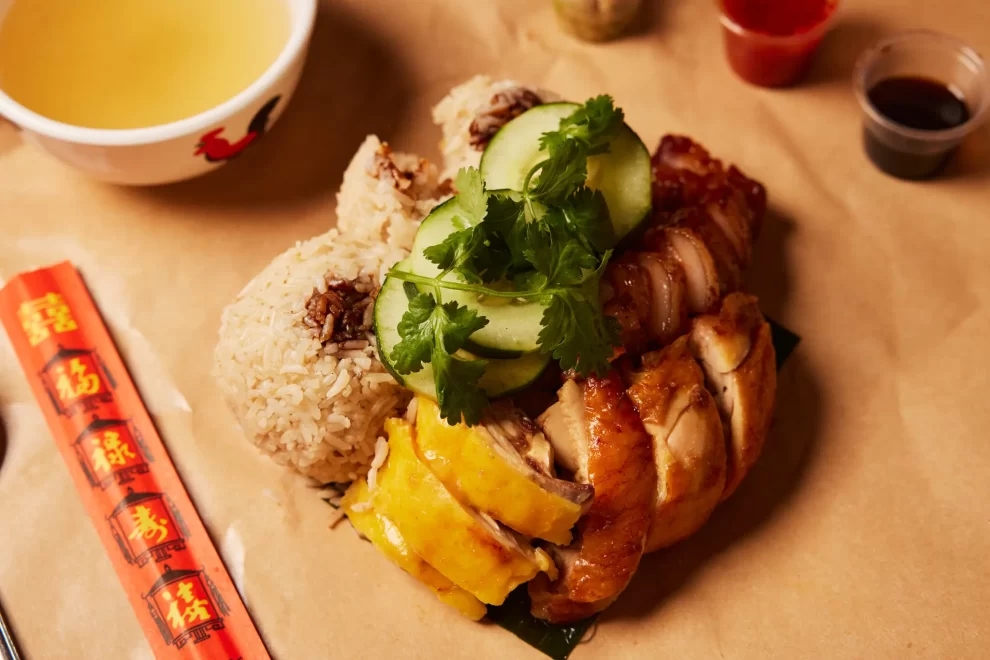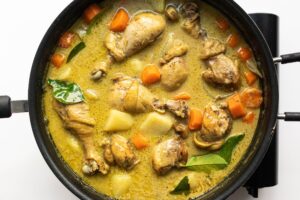Hainan Chicken House in Sunset Park, Brooklyn, is decked out in images of poultry — a tribute to its specialty, chicken rice.
Poached chickens and roasted chickens dangle in the window of Hainan Chicken House on Eighth Avenue in Sunset Park, Brooklyn. A chicken-size sculpture of a chicken stands above the door. Scattered among the plain white tiles on the dining-room walls are other tiles printed with images of chickens. And if you order one of the noodle soups, it will come to the table in a white bowl with a picture of a chicken on the outside.
Astute readers will have noticed a decorative theme. In fact, the motif extends to the menu. Hainan Chicken House is dedicated to Hainanese chicken rice, a dish with ancient origins on Hainan Island in southern China. It has since traveled, along with Hainanese cooks, to Vietnam, Cambodia, Thailand, Indonesia, Singapore, Malaysia and beyond, putting down deep roots wherever it lands.
The owners of Hainan Chicken House are Malaysian New Yorkers, and it is the Malaysian version of chicken rice that they serve, along with curry laksa, mee goreng and a few other classics of the cuisine. What is called the House Hainan Chicken at Hainan Chicken House comes to the table wrapped in paper, hawker style, and sealed by a sticker printed with an image of a chicken. Inside are two balls of rice, a cilantro branch, slices of cucumber and poached chicken hacked into pieces with a cleaver.

One peculiarity of Hainanese chicken rice is that the chicken may be the least important part of the dish. Certainly it takes a back seat to the rice, which is usually cooked in chicken stock and lubricated with rendered chicken fat. The rice at Hainan Chicken House tastes of chicken, but doesn’t taste like chicken; it is especially nuanced, fragrant with jasmine, pandan, lemongrass and fried shallots, among other aromatics. (For the flavor of chicken, bright as a searchlight, sip on the warm bowl of broth that accompanies the butcher-paper packet.)
Depending on your point of view, the meat may also take a back seat to the three freshly made condiments it is served with: sesame-scented dark soy, a potent ginger-scallion paste and a red-chile sauce, spicy and fruity and a little sour. The chicken itself is not without flavor — like the rice, it has been poached in stock — but the pleasure of eating it is in the texture, the way it is firm and yielding at the same time, floppy and juicy all the way through.

In New York, when you imagine a plate of chicken rice, chances are the chicken you picture is poached. In Asia, there is some flexibility on this subject, and “chicken rice” may be eaten with roasted or even fried chicken. Hainan Chicken House’s fried chicken is coated in a thick, craggy shell over which has been spooned a sort of coconut milk gravy with a slow-burning heat. It is very good, but to my mind the more natural partner for the restaurant’s chicken rice is the roast chicken, its skin stained with soy and its meat infused with spices and washed with fragrant dripping fat.
Best of all, though, is the char siu pork belly, carved into small sweet concentrated bits that I would like to keep in a jar so I can eat them like jelly beans. If you eat this, though, what you have is no longer chicken rice but roast pork with chicken rice.
If that, along with a green vegetable like stir-fried Chinese broccoli or watercress, were the whole menu, Hainan Chicken House would be the leading contender on the very short list of local kitchens that understand how to make good chicken rice. This was more or less what the chef, Hann Low, had in mind last year when he told his son Christopher and daughter, Rebecca, that he had been dreaming of opening a restaurant. For years he’d cooked Thai food, tapas and other things in restaurants around the city. Now he wanted a simple Malaysian place, like his parents’ kopitiam, where he’d learned to make Hainanese chicken rice before he moved to the United States.

The restaurant he built with his children and two other relatives expanded on that idea, but not by much. To the Hainanese chicken and char siu, they added a handful of classic Malaysian dishes, noodle soups and fried noodles. The limited menu makes Hainan Chicken House closer in spirit to a hawker stall than to some other restaurants in the city that prepare dozens of Malaysian dishes but do justice to few.
In fact, much of the cooking has the practiced, steady intensity that has been missing so far from many of the stalls at Urban Hawker in Midtown.
For his Penang prawn noodle soup, Mr. Low brews a broth from dried and fresh chiles; the shrimp paste belacan, with its room-filling pungency; and shrimp heads and shells and tails seared until they smoke. In his curry laksa, a rich and fiery lake of coconut broth, aromatic with curry leaves, clings to the thick egg noodles and crisp mung-bean sprouts.


In the sauce that coats stir-fried egg noodles and seafood in mee goreng, sweetness and heat are wrapped tightly together until they become one idea. Char kway teow is more charred and intense than some local versions, cooked in a wok so hot that smoke seems to be rising from the bands of rice noodles tangled with shrimp and clams when they arrive at the table.
Generations of recipes coexist on the menu. The curry puffs — peppery potatoes inside shattering half-moon shells of pastry — come from Chris and Rebecca’s maternal grandmother. There are never enough of them to keep up with the demand.
Then there is the chicken liver mousse. The livers are seasoned with ginger and scallions, fortified with Shaoxing wine and served on Malaysian cream crackers. So far we are on solid Asian ground, but the garnish is Eastern Europe by way of the old Lower East Side: gribenes, the cracklings that are a byproduct of rendering fat for schmaltz (or, in this case, for chicken rice). It is a classic second-generation idea.

Specials may serve as tryouts for the permanent menu, which seems destined to grow. Seasonal vegetable specials scrawled on the wall have included okra in a golden batter with a sambal mayonnaise the color of a Tequila Sunrise.
Sometimes there is assam laksa, a fish-and-noodle soup with a spicy undertow and a streak of acidity provided by tamarind and fresh pineapples. I hope it gets a spot on the menu, though it just might deserve its own restaurant.
Source : The New York Times

























